335345435
dec . 05, 2024 14:33 Back to list
different types hydraulic fittings
Understanding Different Types of Hydraulic Fittings
Hydraulic systems are an essential part of various industries, including manufacturing, construction, and automotive. They rely on fluid power to operate machinery and equipment efficiently. A crucial component of these systems is hydraulic fittings, which connect hoses, tubes, and pipes, ensuring that the hydraulic fluid flows smoothly and safely. This article will explore the different types of hydraulic fittings, their functions, and applications.
What Are Hydraulic Fittings?
Hydraulic fittings are connectors that facilitate the flow of hydraulic fluid between different components in a hydraulic system. They ensure a secure and leak-free connection and are designed to withstand high pressure and temperature. Depending on the specific requirements of a system, hydraulic fittings come in various shapes, materials, and sizes.
Common Types of Hydraulic Fittings
1. NPT Fittings (National Pipe Tapered Fittings)
NPT fittings are widely used in hydraulic applications due to their tapered threads that create a tight seal. They are typically made of steel, brass, or plastic and are easily threaded into the system components. NPT fittings are common in low-pressure applications but are also suitable for moderate pressure levels.
2. BSP Fittings (British Standard Pipe)
BSP fittings are similar to NPT fittings, but they are used primarily in British and Commonwealth countries. They come in both parallel and tapered threads. The compatibility of BSP and NPT fittings is a vital consideration when working on international projects. BSP fittings are often preferred in industries working with water and other fluids.
3. JIC Fittings (Joint Industry Council)
different types hydraulic fittings

JIC fittings are characterized by a 37-degree flare at their connection points. This type of fitting is commonly used in high-pressure hydraulic applications due to its ruggedness and reliability. JIC fittings provide excellent sealing capabilities and are often utilized in automotive and aerospace applications.
4. AN Fittings (Army-Navy)
AN fittings are military specifications used for hydraulic systems in aviation and motorsports. They have a similar flare to JIC fittings but are typically made from lightweight materials, such as aluminum. AN fittings are known for their ability to withstand extreme conditions, making them ideal for high-performance applications.
5. Quick-Connect Fittings
Quick-connect fittings enable rapid connection and disconnection of hydraulic lines without the use of tools. This feature is particularly useful in applications where frequent changes or maintenance are required. Quick-connect fittings can be found in various styles, including couplers, sockets, and plugs, and are commonly used in agricultural equipment and industrial machinery.
Material Considerations
The material of hydraulic fittings greatly influences their performance and durability. Common materials used include
- Steel Known for its strength and resistance to wear, steel is often used in high-pressure applications. - Brass This material is resistant to corrosion and is typically used in lower pressure and non-critical applications. - Stainless Steel Ideal for environments where corrosion is a concern, stainless steel fittings provide excellent durability and performance. - Plastic Often used in light-duty applications, plastic fittings are lightweight and resistant to corrosion but are not suitable for high-pressure situations.
Conclusion
Understanding the different types of hydraulic fittings is crucial for anyone working with hydraulic systems. The choice of fitting can significantly impact the efficiency and safety of the system. Whether dealing with NPT, BSP, JIC, AN, or quick-connect fittings, it is essential to select the right type based on the application requirements and ensure compatibility with other system components. Proper installation and maintenance of hydraulic fittings play a critical role in the overall performance and longevity of hydraulic systems. By choosing the appropriate fittings and materials, professionals can create efficient, reliable, and safe hydraulic operations.
-
SAE 100 R17 Black Smooth Cover Hydraulic Hose
NewsMar.07,2025
-
SAE 100 R17 Black Smooth Cover Hydraulic Hose
NewsMar.07,2025
-
SAE 100 R17 Black Smooth Cover Hydraulic Hose
NewsMar.07,2025
-
SAE 100 R17 Black Smooth Cover Hydraulic Hose
NewsMar.07,2025
-
SAE 100 R17 Black Smooth Cover Hydraulic Hose
NewsMar.07,2025
-
steel wire braided hydraulic hose
NewsMar.07,2025



